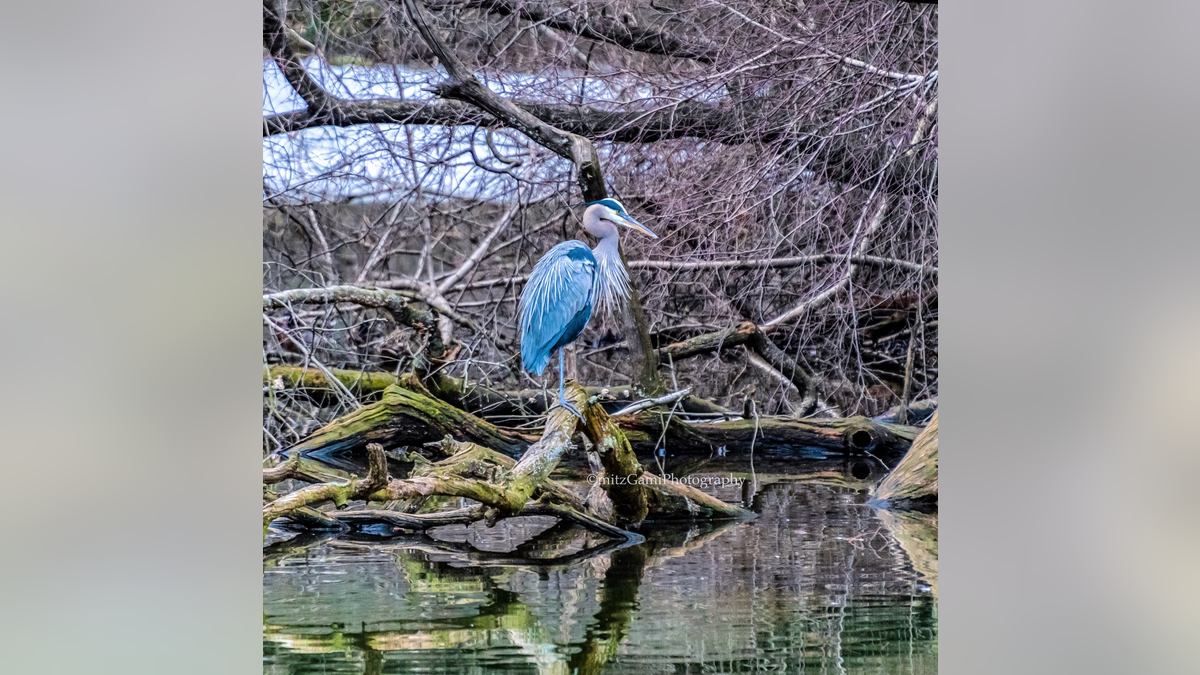
Does Central Park's Mandarin duck have competition with a Great Blue Heron? (Rosalie Quinto-Demigo)
Move aside, Mandarin duck: An electric-blue Great Blue Heron is the latest bird in New York’s Central Park to steal the spotlight.
A photo of the majestic creature was shared on Twitter last week by photographer Rosalie Quinto-Demigo after she spotted the Great Blue Heron at The Pond, which is also home to the viral Mandarin duck.
NEW YORK’S CENTRAL PARK IS NOW HOME TO A RARE AND COLORFUL MANDARIN DUCK
But unlike the colorful duck — which is a rarity for the area, as it’s native to East Asia — the Great Blue Heron is no stranger to the city’s famed park. In fact, according to birder David Barrett, who manages the Twitter account Manhattan Bird Alert that keeps New Yorkers up-to-date with rare bird sightings and beyond, Great Blue Herons can be seen throughout the year.
“They will stand in shallow water and try to be as still as possible and wait for fish to come by. When they see it, it coils its neck and gets ready to strike, using its long bill as a spear."
“[You] might see one or two in the park at any given time throughout the year,” he told Fox News. But, he noted, “they’re never seen in large numbers.”
That said, the photo of the long-legged bird likely helped propel it to fame, prompting news outlets to quickly cover the heron’s presence at the park.
Barrett said the Great Blue Heron that Quinto-Demigo snapped a photo of hasn’t been seen at The Pond since last week. But the bird could return, as these creatures “tend to follow patterns,” he noted.
“These birds come back to places where they find food; they like to fish on small ponds and lakes,” he explained, adding other Great Blue Herons have been seen by bird watchers on Randall’s Island and near Inwood Hill Park.
A largely solitary bird, the Great Blue Heron feeds itself by stabbing fish with its long bill.
“They will stand in shallow water and try to be as still as possible and wait for fish to come by. When they see it, it coils its neck and gets ready to strike, using its long bill as a spear,” Barrett said. “Like a sling that shoots [its] bill into the fish."
When they’re not fishing for food, these “elegant and graceful birds look like gliders when they go across the sky,” he continued.
110-MILLION-YEAR-OLD BIRD FOSSIL FOUND WITH EGG INSIDE
The Great Blue Heron may not frequent the pond as much as spectators would like. But there's still plenty of eye candy: the famed Mandarin Duck (which, despite Barrett’s concerns it could not withstand colder temperatures, survived the winter just fine) — or New York’s so-called “hot bird” — is still floating in the pond alongside the less-colorful mallard ducks.
Other species of birds, too, are making their way to Central Park as the weather warms. Barrett said bird enthusiasts can soon see great egrets (not the same as but similar to Great Blue Herons) in the park, while American woodcocks are currently making a home in the city’s Bryant Park.
